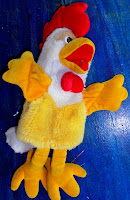Puppets: None
Props: None
Technology: Projector for scanned images; Internet to play embedded videos
Presenters: one
Audience: Family Storytime (mostly 3-6 year olds)
 I wanted to include a non-fiction book for our “Bugs” storytime, and using a portion of Bugs A to Z worked pretty well. This book has a full color photograph of a bug for each letter of the alphabet, plus a couple paragraphs of basic facts. For storytime, I scanned six of the more familiar bugs: Ants/Aphids; Dragonflies; Honeybee; Fireflies; Ladybugs; and Grasshopppers. I first showed the letter (“G is for….”) and asked the kids to guess. This worked best when I gave them really good clues: “It’s green and it hops…” (and if the child I call on doesn’t get it: “It hops on the grass…and it starts with ‘grass…’”).
I wanted to include a non-fiction book for our “Bugs” storytime, and using a portion of Bugs A to Z worked pretty well. This book has a full color photograph of a bug for each letter of the alphabet, plus a couple paragraphs of basic facts. For storytime, I scanned six of the more familiar bugs: Ants/Aphids; Dragonflies; Honeybee; Fireflies; Ladybugs; and Grasshopppers. I first showed the letter (“G is for….”) and asked the kids to guess. This worked best when I gave them really good clues: “It’s green and it hops…” (and if the child I call on doesn’t get it: “It hops on the grass…and it starts with ‘grass…’”).  Then the photo is on the screen, and these are large enough and clear enough to be pretty impressive visually. I share a fact or two from the text, but not everything with this age group. Reading this book one on one I would read it all, but for a group it needed to be simple and graspable. So for ladybugs: “If they are in danger, they can pull their head under their shell...” and that's enough. Our little laser pointer came in handy for showing the ladybug’s head, the grasshopper’s wings and feet where they rub them together, etc.
Then the photo is on the screen, and these are large enough and clear enough to be pretty impressive visually. I share a fact or two from the text, but not everything with this age group. Reading this book one on one I would read it all, but for a group it needed to be simple and graspable. So for ladybugs: “If they are in danger, they can pull their head under their shell...” and that's enough. Our little laser pointer came in handy for showing the ladybug’s head, the grasshopper’s wings and feet where they rub them together, etc. This all would have worked fine, but to make it even more engaging I added a short Youtube video for three of the six insects. The photo (above) shows the dragonfly’s two sets of wings very nicely. But when you can then show a slow motion video (below) that clearly shows how the wings don’t move in unison, it really comes through well. For the fireflies, the film showed a night sky with fireflies flickering in the distance and the kids had fun spotting them before they quickly disappeared. We ended with the “song” of the grasshopper. In the video you can just see the legs moving against the wings.
Normally I feel a bit hesitant to add a video feature, since it seems like it might lead kids away from library books for learning. But the truth is kids can and do learn a lot from both, and I felt like the film clips supported the words and photos without detracting from them. We had a bunch of other non-fiction insect books for preschool age kids (or close) on our book display table, and letting the audience know about these as the conclusion for this book led to a lot of checkouts.




















